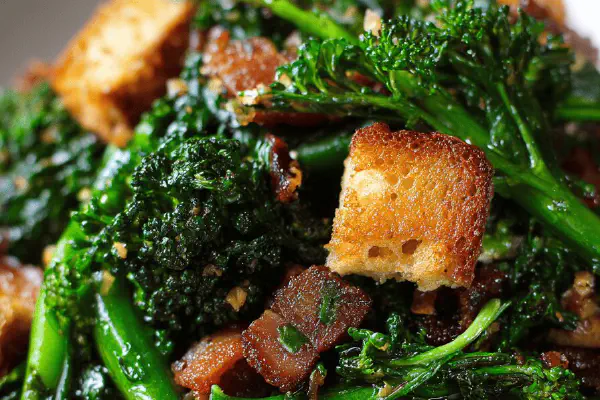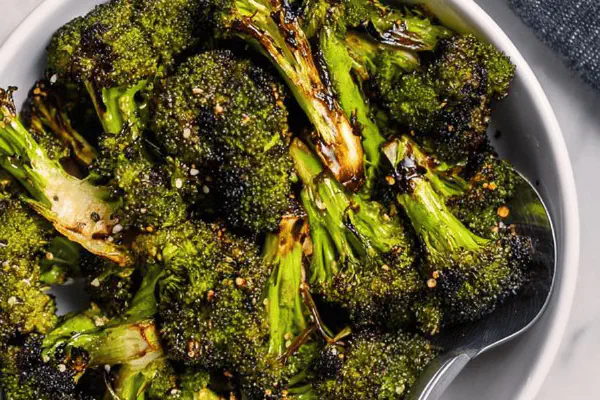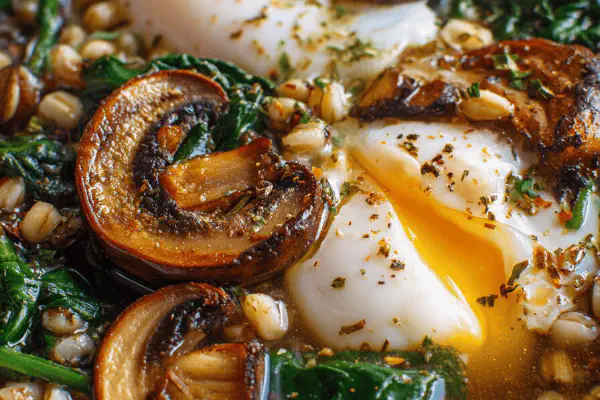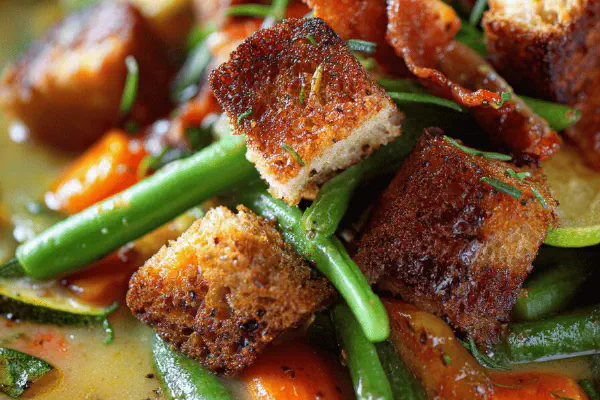Green Veggies Red Wine Sauté

By Emma
Certified Culinary Professional
Ingredients
Red Wine Reduction
- 280 ml (1 1/5 cups) red wine
- 55 ml (3 1/2 tbsp) honey
- 3 ml (3/4 tsp) cracked black pepper
- 1 small cinnamon stick, approx 2 cm
Croutons
- 2 garlic cloves, halved
- 60 ml (4 tbsp) olive oil
- 120 g (2 1/2 cups) stale country bread, cubed
Vegetables and Pancetta
- 180 g (6 oz) pancetta, diced
- 1 medium red onion, thinly sliced
- 3 garlic cloves, minced
- 40 ml (2 2/3 tbsp) olive oil
- 250 g (9 oz) green beans, trimmed and lightly steamed
- 1 small head cauliflower, cut into small florets, steamed till tender-crisp
- 200 g (7 cups) curly kale, roughly chopped
- Salt and pepper to taste
About the ingredients
Method
Vegetables and Pancetta
- Heat oil in a large skillet, medium-high. Render pancetta until edges crisp and fat starts to bubble, maybe 7-8 minutes. Low and slow breaks fat down; rushing leaves chewy bits. Remove pancetta, keep fat for cooking veggies. Toss in onion and garlic; sauté until translucency hits, aroma thickens, edges just turning golden, about 4 minutes. Add steamed green beans and cauliflower; give them a thorough toss to coat in fat. In with kale; it’ll shrink fast but don’t overcook. About 6 minutes sauté, kale softening but still with tooth. Salt sparingly here—pancetta's salty, reduction adds pepper kick.
Red Wine Reduction
- Meanwhile, in a small saucepan, dump wine, honey, cracked pepper, and cinnamon stick. Medium heat to bring bubbles up. Keep an eye; reduce by nearly half, thickening to syrup that coats a spoon, glossy and sticky. Smell should shift from sharp alcohol to rich fruitiness with honey’s warmth. Strain out cinnamon bits to avoid woody surprises later. Don’t reduce too far or sugar burns—bitterness kills the sauce.
Croutons
- Use leftover or day-old sturdy bread for best crunch—softer bread sogs out. In a dry skillet, warm olive oil with garlic halves over medium heat. Let garlic infuse oil, released scent fills kitchen; toss bread cubes in, stir often. Aim for golden toasted all around, crisp but not burnt—around 7 minutes. Drain on paper towels, press lightly to remove excess oil.
Assembly
- Dish sautéed veggies tossed with pancetta pieces on large platter. Sprinkle croutons just before serving for crunch contrast. Drizzle reduction thinly over top, enough to glisten but not drown. The interplay between the sweet-tart reduction and smoky pork, crisp crouton, and fresh greens is striking. If reduction thickens too much by serving, warm gently and add splash of water or stock.
Tips & Variations
- Switch pancetta with smoked tofu for vegetarian option; it absorbs all those deep flavors. Use kale only if bunches are young—old kale toughens quicker. Cauliflower adds a nutty tone; broccoli can replace but watch steaming time for softer bite. White wine, like a dry sauvignon blanc, works if red not around—color and depth shift but still compelling. Too salty vegetables? Blanch longer or rinse quickly after steaming. For crunch alternative, chopped toasted nuts sprinkled on top provide a delightful texture twist, try toasted walnuts if no allergies.
- Cooking times sketchy; watch textures and aromas instead. Don’t rush reduction or you’ll mistake bitter for flavor. When in doubt, err on side of less salt, add more at plate. Oils must be fresh, stale olive oil kills brightness. Garlic shouldn’t burn—brown but not black, else bitterness seizes dish.
- Served alone, makes a hearty veggie side; paired with charred pork chops or herb-rubbed roast chicken, meal sings notes of rustic French countryside. Sunday dinners, casual suppers, whatever fits. I like to prep reduction first to let it cool and thicken, gives me margin to time croutons and sautéed greens precisely.
Cooking tips
Chef's notes
- 💡 Render pancetta slow. Medium-high but patient. If it crackles too loud like popcorn, dial heat down immediately. Fat melts out clear; don't rush fat breakdown or you get chewy bits. Keep rendered fat in pan; that’s main flavor punch for veggies. Toss onions and garlic in that same fat. They soften and get that faint golden edge before veggies hit pan. Timing is key here; skip translucency and flavor suffers.
- 💡 Reduce wine on medium, not high. Bubbles need to come gently, watch tight. Vapor aroma shifts from sharp alcohol to warm fruity. Stop thickening once reduction coats spoon but still pourable. Over-reducing means burnt sugars and bitter notes kill sauce appeal fast. Strain out cinnamon early to catch woody bits, no surprises in final pour. Honey’s sweetness balances tartness, but caramelize it? Nope, that slants flavor bitter.
- 💡 For croutons, stale bread is best. Fresh bread gets soggy fast. Heat olive oil slowly with garlic halves to infuse oil without burning the cloves. Garlic darkens quickly; burnt equals harsh bitterness. Toss bread cubes often but gently in warm oil. Even golden all sides but don’t let cubes burn. Drain on paper towel and lightly press to shed excess oil. Crunch holds up longer if oil isn’t overloaded.
- 💡 Steam veggies just till tender-crisp. Overdo and you lose texture and color; underdo and raw harshness masks flavors. Green beans, cauliflower, kale shrink differently. Kale cooks quick once added—soften but keep tooth to avoid limp mush. Salt veggies at the very end or just before serving. Pancetta and reduction already add salt and pepper punch; oversalting kills balance.
- 💡 Veggie swaps work but watch cooking times. Broccoli instead of cauliflower cools nutty tone but steams faster—adjust accordingly. Smoked tofu can replace pancetta for non-meat option but lacks rendered fat flavor; boost oil or add smoky spices to simulate that layer. White wine, dry styles only, but note shift in sauce color and tone. For crunch alternatives, chopped toasted nuts—walnuts for boldness—scatter on top; adds texture and contrasts soft veggies.
Common questions
How to avoid bitter reduction?
Keep heat medium, reduce slowly. Watch honey caramel closely. Burnt sugar bitter, no fix later. Strain cinnamon early. Overcooking kills sauce. No shortcuts here.
Can I swap pancetta with bacon?
Yes but bacon fattier and smokier. Pancetta cleaner fat, subtle flavors. Bacon alters aroma more. Smoke level varies. Adjust oil – bacon usually releases more grease so less added oil needed.
Why do croutons get soggy?
Often bread too fresh or oil too little/too much. Dry stale bread best. Infuse oil with garlic gently; burn garlic equals bitterness spreads. Toast evenly, stir lots. Drain thoroughly after cooking. No soaking bread in oil.
How to store leftovers?
Keep veggies separate from reduction to avoid sogginess. Refrigerate airtight containers. Croutons off to side, store dry. Reheat reduction gently with splash water. Veggies warm in skillet, toss briefly. Croutons crisp again in oven or pan quick. Don’t microwave croutons, turns chewy.



